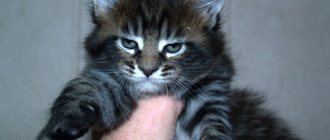The native English breed has an appearance that cannot be confused with other cats. As for amateurs, their knowledge is not as rich as that of experienced felinologists. Therefore, in order to distinguish a British cat from an ordinary street cat, you need to study the characteristics of this breed - its character traits and external signs.
What to prepare for the kitten's arrival
If the choice of the future pet has already been made, all that remains is to wait until it grows a little and can leave the nursery. It is necessary to prepare and foresee a lot for his arrival.
First of all, buy:
- carrying;
- a house or bed for sleeping;
- scratching post;
- bowls and food containers;
- dry and wet food;
- litter tray;
- filler;
- toys;
- accessories and grooming products.
Carrying
Carrying is necessary for safe transportation. They will not allow you to pick up an animal from a professional nursery in her absence. Moreover, this item will come in handy more than once in the future - when traveling to the veterinarian, to the country, or on vacation to another city or country.
Pet stores now offer a large selection of carriers of different sizes and from a variety of materials - rag, in the form of bags made of leatherette and plastic.
The latter option is preferable, as it has a large internal volume, rigid and durable walls, and retains its shape. If in the future it is possible to fly with your pet on an airplane, then you need to choose exactly this model, since airlines have special requirements for the luggage container.
It’s better to immediately choose a fairly expensive carrier, with a metal door and strong fastenings. You should not buy a small one, the baby will grow within a year, and adult British cats can reach a weight of six kilograms. Estimated price - 2-3 thousand rubles.
At first, with the door removed, the plastic carrier can also serve as a place to sleep.
Cat house and scratching post
In specialized stores, you can choose an option that will suit everyone - it will suit your pet in size and fit well into the interior of the house. There are many options for cat houses.
The most convenient one for a Briton is a small one on a round stand, which also serves as a scratching post. This breed is not very active and large play structures will not attract the kitten's attention.
The preferred upholstery option for the house is carpet; it washes best and lasts longer. The rope on the scratching post should preferably be jute. Although at first there will be a little garbage from it, any cats give it preference over other options and willingly sharpen their claws.
This design can be purchased for 4 thousand rubles.
You can get by with a bed, but this is a less convenient option. It wears out faster and requires frequent washing. The minimum cost is 1000 rubles. And in this case you will have to buy a scratching post separately. A small corner corner made of carpet will also not cost less than a thousand. But it quickly breaks down, and kittens are not too fond of such material.
Bowls and food containers
Among the huge variety of cat dishes, you should choose one that is comfortable for your pet and made from safe materials. This is stainless metal and earthenware.
A double bowl on an adjustable stand for water and dry food is very practical. You can buy a separate earthenware plate for wet and natural food. All three will cost 1-1.5 thousand rubles if chosen correctly.
The height-adjustable stand is very convenient - for a kitten you can lower the bowls to the lowest level, for an adult cat you can raise them. This accessory is pet-friendly and stable - it won't slide on the floor when the animal is eating.
A small container for food is also desirable; you can pour dry mixture (0.5-1 kg) into it and always keep it in the kitchen. It is usually made of metal and beautifully designed. This accessory is inexpensive - from 200 rubles.
Stern
First of all, you need to ask the breeder what kind of diet the British baby had in the nursery. For the first time, it is necessary to purchase exactly the food that the kitten is accustomed to.
If the desire arises, you can gradually transfer it to another, but not in the first days after the move.
Several bags of high-quality wet food are also necessary, even if you do not feed them to the animal in the future. In the first days at home, the baby will experience stress and may refuse to eat. This delicacy usually creates an appetite.
The cost of super premium food starts from about 500 rubles per 1 kg.
Toilet and litter
The acquisition of these important items must be taken seriously. First of all, find out from the breeder what kind of toilet and litter the British kitten uses in the nursery.
Experienced breeders never set up a separate small tray for babies; kittens, looking at their mother, begin to go to the same toilet as her.
Usually in nurseries they use closed toilets of the “house” type. They often consist of two compartments, one of which contains a grid for cleaning the paws. Such a toilet is not cheap and can cost about 5 thousand rubles, but it is made of high-quality plastic that is easy to clean, will never break and has bactericidal properties (with silver ion deposition).
They are usually equipped with special filters for air purification.
For small kittens, wood filler is preferable; most likely, this is what the baby is used to in the nursery. This is the most inexpensive and safest option. A 15 liter bag costs about 500 rubles.
Don't forget about a special scoop for cleaning the toilet.
Toys
Simply necessary in the house - balls, swings, mice made of natural fur, interactive ones. It is important that they are made of safe materials and do not have small parts that come loose. 1000 rubles are enough to purchase them. The missing ones can be easily made with your own hands from old clothes or a cardboard box.
Accessories and grooming products
A whole list of items is needed here:
- metal combs of two types - with a frequent and rare comb;
- massage brush for combing;
- nail clipper;
- lotions for the care of ears and eyes;
- shampoo for kittens;
- first aid kit;
- sprays for toilet training (you may need them at first).
These acquisitions will cost 2000-3000 rubles.
Kitten 1 month
The period of appearance of bear-type kittens. Month-old kittens are formed unevenly; a large body on short thick legs reminds us of a small bear. They sleep 16–20 hours, are very active, and play a lot.
4 weeks
Month-old kittens drink water on their own for 4 weeks, many eat wet and dry food themselves, and go to the litter box. Time to work with the kitten and adapt to the hands, teaching manners. The “change of color” of the eyes from blue to orange (for blue color), this happens gradually.
1 month
5 – 6 weeks | After 1.5 months, the kitten licks its fur and washes itself, the undercoat thickens, and the color becomes brighter.
5 weeks
At 7–8 weeks, babies are still drinking their mother’s milk and learning cat wisdom from her. The eyes acquired their color, became bright and clear.
1.5 months
How to keep your kitten safe
British babies are just as restless and inquisitive as kittens of more active breeds, such as the Bengal or Abyssinian. As soon as they get comfortable in their new home, they will definitely crawl into every corner and explore all the cabinets and tables.
It is the responsibility of the owner and all household members to ensure the safety of pets. Little Britons need care and attention just like ordinary children.
To protect the British from danger and prevent irreparable consequences, the following measures must be taken:
- Do not let the kitten alone in the toilet room, especially when the water is filling the bath. The toilet lid must always be closed. Although a cat can swim, a kitten can easily drown; he simply cannot get out of the water.
- All medications and household chemicals must be placed in closed cabinets. One of the most frequent calls to veterinary clinics today is poisoning of kittens under one year of age.
- All windows that are usually opened for ventilation should have special screens. If a small British kitten falls even from the second floor, he could die or be seriously injured. By the time the baby grows up, anti-cat nets should be on all windows in the apartment, if it is a multi-story building.
- While the baby is small, you should not leave him alone for a long time, unattended. If he climbs onto a tall cabinet, he may also break. It is also better to hide small objects and toys. It is better, when leaving, to lock it in a room where there are no dangerous objects.
- In a private house, you must ensure that the doors to the garage, boiler room, and utility rooms are always closed. Poisoning, for example, with antifreeze, often costs a child’s life.
- The garbage container in the kitchen should be closed or kept out of reach of the pet. The kitten can be poisoned by the remains of low-quality or unsuitable food or be injured by sharp objects, such as metal cans.
- Rodent traps and cockroach baits are strictly prohibited in the premises where a British kitten lives.
Prohibited Products
British cats should not be fed the following foods:
- fatty meat;
- bones;
- river fish;
- fatty fermented milk products;
- egg white;
- sausages;
- conservation (for people);
- fried foods;
- spicy and salty foods;
- sweets, chocolate;
- baking, baked goods;
- food from your table.
The right approach to feeding a British breed cat is the key to good health and long life for a furry family member!
Ideal age to move
Many future owners want to monitor the growth and development of a British baby from an early period, at least from four weeks. But it is absolutely forbidden to take such a pet away from its mother.
The ideal age to move is three and sometimes four months.
By 12 weeks, a British kitten is more or less ready for independent living. It is at this age that the baby stops sucking mother’s milk, learns to eat solid food, and his own immunity begins to develop.
It is the mother who must do the weaning. If this procedure is carried out forcibly, then, in addition to health problems, behavioral disorders will certainly arise. Early weaning is also fraught with the development of diseases of the respiratory system, diarrhea and, as a result, dehydration.
Both vaccinations against panleukopenia, calcivirus and rhinotracheitis have already been carried out, which means the baby has immunity to these diseases.
The kitten is physically strong enough to move. At two or three months he received from his mother the skills of using a litter tray.
When parting with its mother early, the emotional state of a British kitten suffers greatly, since it is she who teaches how to communicate with people and other animals. A three- to four-month-old baby perceives new faces not with fear, but with curiosity. Therefore, it is worth listening to the opinion of the breeder and picking up a British kitten from the nursery at 12, and sometimes at 16 weeks.
Russian nurseries
Where can you buy a British kitten in Moscow:
- Tamaky*ru, Cattery of British cats Moscow. They offer British Shorthair kittens of different colors and ages with vaccinations and certificates.
- Style of Provence, nursery of British cats by Lyudmila Mikheeva. They have been breeding professionally for 10 years. Pets are offered vaccinated, trained and with a set of bright photographs.
- Joy Land, a British cattery, breeds pets of blue and lilac, cream and cinnamon colors.
Before you bring the furry miracle home, you need to remember: an animal, not a toy. This is a living creature, small and defenseless. And it is the owner’s responsibility to take care of it.
Moving and adaptation of a British kitten
The first days in a new home are the biggest stress for a baby. Correct behavior by the owner will help the kitten quickly get used to it and survive this difficult period, which takes from three days to two weeks.
It is better to organize your pet's move on the eve of the weekend or vacation in order to give him maximum attention.
First of all, for quick adaptation it is necessary to limit the space. This means that without a person, the kitten should only be in a small room.
It is advisable that there are no unnecessary objects or secluded places where you can hide. The carrier in which he arrived, the house or bedding, the toilet and bowls of food and water should be close to each other. Once the pet gets comfortable, the tray can be moved to its designated place and the doors to other rooms can be opened.
If you immediately let the kitten walk around all the rooms, it may get confused, not find the toilet, and hide in a dark corner out of fear.
Surrounded by objects that he immediately recognizes as his property, the baby quickly recognizes himself in a new home.
You should not force your little Briton into your arms. Even if he begins to purr, but his body is tense, this is a manifestation of fear, not pleasure. Soon he will get comfortable and ask for affection himself.
But the baby must eat regularly. If he is on a natural diet, then 4-6 times a day. With a diet consisting of dry high-quality food, 3-4 feedings are sufficient. Constant access to clean water is required.
It is important to talk kindly to the kitten, not to raise your voice or get angry with him, even if he broke something or went to the toilet in the wrong place. The baby is very sensitive to any emotions.
If there is another animal in the house, then you need to introduce the pets very carefully. It is better to wipe a piece of suede first on the old-timer and then on the baby, then the latter will be safe - the adult cat will not touch him.
Birth
In general, cat pregnancy lasts about 56-63 days. The period depends on the breed for many other reasons. It is impossible to say exactly how long cats are pregnant or how long gestation lasts. Factors influencing duration:
- Weight.
- Presence of previous attacks.
- The relationship between the time of the first estrus and mating.
It is advised to breed a female cat on her third heat, trying to avoid protracted previous periods. If the pet is taken to a partner earlier, the animal will bear kittens for about 50 days. The babies may appear premature or dead.
The weight of the pet is also important when determining the timing of the cat's death. Small beauties, weighing about 3 kg, bear kittens faster, how long do small British cats walk before permission is known. Cubs appear earlier, at 55-56 days. Large adult, sedentary individuals migrate at 64-65 days and can walk beyond the established period.
How many kittens an animal gives birth to depends on the time at which the process occurs; a British cat brings no more than three babies for the first time. Typically, primiparous cats are delivered on time at 63 days. Labor lasts approximately 2 to 14 hours.
It often happens that there is only one kitten in the first litter. And this is from mating with a pet, which can produce up to 7-8 babies. There is no need to be afraid and try to stimulate the appearance of more: each animal’s body has its own characteristics. It is not so important the number of litters a cat produces from the first time, and how many kittens the British favorite will give birth to. You need to worry about the condition of the animal and its offspring.
When to start - tips
Small pets should not be taken away from their mother too early. The main reason for this rule: the baby must be fed breast milk and will learn hygiene skills from an adult cat. The optimal age for moving to another family is 3 months, the cub will be about 12 weeks old.
Smell and touch are the main helpers of a kitten in the first days of birth. The baby does not hear or see yet: he finds his mother’s warm side and nipple by smell. The organs of vision begin to function 10-14 days after lambing. In many ways, the opening of the eyes depends on gestation, that is, on how long the cat carried the kitten. Premature babies will develop the ability to see later. Those born later will see the world faster.
The development of female pets is more intensive. The girl's eye slits become wider earlier than those of her furry brothers. The breed of the animal also matters. British Shorthairs will open their eyes on the 6th day after birth. And for long-haired breeds, the process of restoring visual activity can take up to 14 days.
In a dark place, the formation of the ability to see will take longer. The deadline has passed, but the baby is still blind. You can help him to open his eyes faster. On the advice of veterinarians, an antibacterial medicine is instilled and the eyes are washed with strong tea and a solution of boric acid.
Regardless of the breed, all babies, including British newborns, have blue-gray eye color. The shell will acquire its characteristic final shade only after 6 months. When kittens open their eyes after 6 days of birth, the habits of the inquisitive baby change.
Proper education of a British kitten
Raising a British child cannot be put off until later. It must be started immediately, from the first minutes in the house, acted kindly and persistently. In no case should shouting or physical punishment be used against an animal.
Subordination and respect for the owner
First of all, the pet must understand that the most important leader in the house is the owner and he must obey him unquestioningly. Usually, if a person does not scream, but strictly and firmly reprimands for a mistake, and affectionately rewards with a treat or toy for correct actions (for example, using a scratching post), then the baby quickly recognizes the owner’s leadership.
It is important to become an indisputable authority for the British from the first days, then there will be no problems in the future mutual existence.
Toilet tray
Usually the toilet issue is the biggest concern of the future owner. But, if you follow all the breeder’s recommendations, then no problems will arise.
Choosing the right tray, limiting the pet's movement around the house in the first two days and the owner's persistence will help solve this problem.
If the baby does not go to the toilet for a long time, then you should drop him off there 10-15 minutes after eating.
Filler taken from the mother's tray helps a lot. A familiar smell will quickly evoke the necessary associations. In the future, it is advisable to leave a little used filler and mix it with clean filler.
If the little Brit gets lost in the first days and forgets where his toilet is, then you can place several trays around the house.
If embarrassment does occur, do not scold the baby. This is not a whim or harmfulness, but the result of stress and fear. The mark must be washed immediately with special products. The disinfectant composition for veterinary use Verocid has proven itself well - it removes any odors. Sometimes toilet training sprays and products like Antigadin help.
At first, you shouldn’t let your kitten uncontrollably onto beds or sofas. If it marks your upholstered furniture, it will be much more difficult to remove the smell. When the period of stress passes, the toilet problem will disappear on its own.
scratching post
A three to four month old British kitten adopted from a nursery will most likely know how to use a scratching post. Even if the excitement of moving made him forget his old skills, they will quickly be restored if the owner behaves correctly.
If space is limited in the first days, the scratching post should be placed next to the house. If there is nothing else suitable for sharpening his claws, the baby will quickly recall his mother’s lessons in his memory.
Feeding
British cats are not whimsical and rarely go overboard with their food, but they still need a balanced diet and clean water.
Take the time to create a special diet for them, because the British have a good appetite and are prone to obesity.
If the food consists of natural products, then it is better to feed:
- beef (lean);
- chicken;
- fish (boiled);
- egg yolk;
- dairy products.
Vegetable puree from zucchini or carrots will also work.
From dry food, it is better to choose Super Premium food, as well as canned cat food, according to their age.
For example, many pet stores offer Royal Canin food exclusively for the British shorthair or longhair breed.
Features of caring for the appearance and health of a British kitten
Caring for the little Briton's coat is very important. The baby's fur seems plush due to the thick and voluminous undercoat. Under no circumstances should it be pulled out. Therefore, a massage brush cannot have metal teeth; it is permissible to use only a rubber one.
Up to six months you can do without triple combing, use only a rubber brush; it will remove excess outer hair from the baby, and the undercoat will not be harmed. It is advisable to carry out the procedure once a week. The pet really likes this accessory - the massage has a beneficial effect on the skin and soothes it. In addition, in this case the wool is not electrified.
An adult British cat, especially during the molting period, is combed first with a sparse comb, then with a frequent comb and a brush. A slicker will only be needed if tangles form. Finally, be sure to remove any remaining hair with wet hands, otherwise it will end up in the kitten’s stomach.
Your pet's nails should be trimmed as they grow, but at least once a month. On the hind legs they often wear out, especially if the floor is made of porcelain stoneware or marble chips. On the front ones, the very tip of the claw is cut off with a nail clipper - no more than one millimeter and always at a right angle.
There is no need to bathe your Briton. A healthy animal takes care of the cleanliness of its fur.
If there is an urgent need for washing (after a walk, diarrhea, severe pollution), then you can only use special shampoos.
The cleanliness of your baby's eyes and ears should be checked daily, as this breed has a tendency to watery eyes and accumulate dark discharge in the corners of the eyes. If they become dirty, clean them carefully using special solutions and drops.
The British are mostly healthy animals. The biggest problem is obesity. Kittens are playful and restless, but adult cats become imposing, leisurely, usually move little and sleep a lot. It is important to choose the right diet from a young age and avoid overeating.
Hypertrophic cardiomyopathy is a rarely inherited genetic disease and is observed in adult males. At risk are kittens that are slowly gaining weight. In this case, it is recommended to periodically visit the veterinarian and have an ultrasound examination of the heart. Urolithiasis is also quite common, especially after castration.
Limits of normal, underweight and overweight cats of popular breeds (tables)
To determine whether an animal is of normal weight or not, sometimes just looking at it is enough, especially if it is short-haired. The stomach of a cat with a deficiency of body weight is sunken, the ribs, pelvic bones, articulations of the ribs with the thoracic vertebrae and the spine protrude, the muscle and fat layers are practically absent.
Obesity in a cat
An obese pet has a large belly without a hint of a waist and a large muzzle. The bones cannot be felt behind a thick layer of fat.
Adult pets
| Kitten age | Weight, g/kg | |||
| Cat | Cat | |||
| Newborn | 60—140 | 70—140 | ||
| 1 Week | 110—250 | 240—260 | ||
| 2 | 150—360 | 340—400 | ||
| 3 | 210—420 | 400—630 | ||
| 4 | 250—600 | 550—740 | ||
| 5—9 | 450—900 | 1,0—1,7 | ||
| 10—14 | 1,0—1,5 | 1,5—2,5 | ||
| 15—18 | 1,7—2,4 | 2,1—3,9 | ||
| 19—23 | 2,2—2,9 | 2,6—4,3 | ||
| 24—28 | 2,3—3,6 | 3,0—5,4 | ||
| 7 months | 2,4—3,9 | 3,3—5,6 | ||
| 8 | 2,5—4,1 | 3,5—6,0 | ||
| 9 | 2,5—4,3 | 3,8—6,4 | ||
| 10 | 2,5—4,4 | 4,1—6,7 | ||
| 11 | 2,5—4,5 | 4,3—6,8 | ||
| 1 year | 2,5—4,6 | 4,5—7,0 | ||
| Adults | 2,5—5,5 | 4,5—8,0 | ||
| Neutered/neutered | 2,5—6,0 | 4,5—9,5 | ||
Sexual development of the British kitten
The period of sexual development begins at six months for the British. But, if cats mature and grow for a long time, usually up to two years, then the situation with females is different.
At seven to nine months the first estrus may begin, and by ten to twelve months the cat is ready to bear and give birth to offspring.
The duration of estrus is from seven to ten days. If fertilization does not occur, then after two to three weeks it will begin again. The female becomes irritable, excited, sometimes even aggressive, screams loudly, some individuals mark their territory like cats.
If the British female is not intended for breeding, then after one or two heats it is necessary to sterilize. You can limit yourself to taking sedatives, but if they are plant-based, they are usually ineffective.
Hormonal drugs reduce sexual activity, but they can destroy a cat’s genitourinary health within six months of regular use.
“Empty” heats not only cause anxiety for the whole family, but also cause the development of endometriosis and pyometra in the female.
What determines a cat's body weight?
This indicator depends on many factors:
- Breed. Representatives of large breeds (Savannah, Maine Coon, Chausie) weigh many times more than their miniature counterparts (Kinkalow, Singapura, Minskin). The British, exotics, Burmese, Sphynxes, and Persians are prone to gaining excess weight.
- Floor. Males are generally larger than cats. Within the same breed, the difference is usually 1–2 kg.
- Castration. After the operation, hormonal levels and the rate of metabolic processes change. The animal requires a third less food. If the caloric content of the diet is not adjusted, weight begins to increase.
- Health status. A deviation from the norm may be a consequence of metabolic disorders, diseases of the adrenal glands, thyroid and pancreas, or pituitary gland.
- Age. Juveniles usually weigh less than older ones. This is due to a decrease in mobility in pets over 7 years of age, a slowdown in metabolism, and hormonal changes.
- Pet constitution. Some are naturally of average build, others are large and muscular, others are thin and graceful. Usually these features are inherited from parents.
In addition to internal factors, external factors also influence the animal’s weight. Body weight largely depends on nutrition and lifestyle. Street cats, forced to get their own food, are much slimmer than indoor cats. The latter move little, do not experience problems with food and often receive it in excess. A cat's diet is not always balanced, which also leads to the cat gaining excess weight.
Annual calendar for caring for a British kitten
For the convenience of owners, all mandatory procedures for caring for the appearance and health of a British kitten are summarized in a table.
| Periodicity | Type of procedure |
| Daily | Combing during shedding season |
| Preventative examination of external condition | |
| Weekly | Cleaning ears and eyes |
| Regular brushing | |
| Monthly | Nail trimming |
| Quarterly | Deworming |
| Grooming (if desired) | |
| 2 times per year | Preventive examination by a veterinarian, urine test for urolithiasis |
| 1 time per year | Preventive vaccination against panleukopenia, rhinotracheitis, calcivirus and rabies |
| Vaccination against lichen |
1111
Price
The prices for these plush cats vary greatly:
- The cheapest British kittens can cost from $50, but it is not known whether it is worth buying for that price, and what they will eventually grow into.
- The average price for a purebred British kitten ranges from $150 to $250.
- The cost of an adult British cat, which can be used for further breeding of the breed, varies from 300 to 500 dollars.
- If you want to buy a show class cat and want to build a show career for it, then be prepared to pay up to $2,000 for it.
Why doesn't the animal gain weight?
During the early stages of life, a kitten should gain weight very quickly, so the owner can easily notice any growth problems, especially compared to other kittens.
If the kitten is not growing, you should pay attention to the following reasons:
In the case of a large litter (more than five kittens), the baby may not have enough mother’s milk or even a free nipple
It is worth paying attention to how well and often he eats, and also apply it to his mother’s nipple yourself. If all the kittens are actively suckling their mother, but are growing poorly, it is worth increasing the amount of food for the mother, adding vitamins and calories. If everything is fine with nutrition, but the kittens are still not gaining weight, they should be taken to the veterinarian. Proper nutrition and sufficient amounts of vitamins are the basis for the normal and rapid development of your pet.
If the weight of babies at a certain stage of life differs greatly from the indicators given in the table, you should consult a veterinarian
Proper nutrition and a sufficient amount of vitamins are the basis for the normal and rapid development of a pet. If the weight of babies at a certain stage of life differs greatly from the indicators given in the table, you should consult a veterinarian.
After castration
After castration, some changes occur in the physiology of a pet; this must be taken into account when compiling its diet. Neutered cats especially often encounter diseases of the genitourinary system and obesity.
- A castrated British cat should consume foods with a minimum content of phosphorus and calcium, since these substances contribute to the appearance of stones.
- Veterinarians recommend excluding cheese and fish from the list of products for the British menu. It is better to replace it with fermented milk products, good and lean meat. The cat should always have fresh water in sufficient quantity and in a clean bowl (such cats may not go near dirty dishes).
- If a cat drinks little after castration, you need to give him more wet food and reduce the amount of dry food.
- What to do with those pets who eat ready-made food? First of all, they should only eat high quality products from reputable manufacturers.
These brands produce special types of food for neutered cats of one breed or another. This food contains those microelements that are necessary for the prevention of diseases of the genitourinary system. Responsible cat owners need to adhere to this rule.
After castration, many cats become less active and quickly gain weight, which can be dangerous for their health. When such a problem occurs, it is necessary to change your usual diet to dietary nutrition. Among ready-made feeds there are options for this situation.
Review of ready-made feeds
If we are talking about raising an elite, purebred animal, you should pay attention to premium and super-premium products from the very beginning. Brands such as Royal Canin even have special food for British kittens in the British shorthair line
Products under the Acana and Chicken Soup brands are considered to be of even higher quality. Of the simpler brands, breeders recommend Hills and Pro Pac. Veterinarians advise owners of British cats to avoid creating an overly rich diet for their pets, since the breed as a whole is prone to gaining excess weight. If you choose a specific brand of food and canned food in pouches or jelly, then you should also choose this particular brand of pate in jars.
If you want to give your pet the best, you should pay attention to the highest-class grain-free product - Earthborn Holistic. The American brand produces a high-protein product with small granules, ideal for both kittens and adult cats.
Another option is Go! Natural, produced in Canada. They are also grain-free and contain a balanced combination of meat, vegetables, grains, fats, and vitamins.
Is it possible to identify a Briton by his behavior?
The character of a British cat is also a serious marker of the species in question. It begins to manifest itself in childhood, and over time acquires all the required features:
- autonomy and independence;
- desire to be alone;
- habit of sleeping a lot;
- tolerates long absence of the owner from the house without any problems.
All basic character parameters can be adjusted only in childhood, but you should not expect that the British dog will become sociable, affectionate and strive for constant communication with the owner.
In the early period, ground rules for living together are laid down and red lines for unacceptable behavior are drawn. If everything is left to chance, the kitten will eventually turn into an aggressive cat that will bite, scratch and make its own rules in the house.
Toilet
Scots, like all cats, are very clean.
Therefore, for a cat to start “doing its business” in the wrong place, it takes a lot of effort! That is, the owner must have done something very wrong. Especially if we are talking about the Scots. Usually it is enough to show the kitten the litter box once, and he will not go anywhere else. What you need to know about cat litter?
1
Very important! The tray must be constantly clean, the filler must be changed on time, and the tray must be washed. With your insensitive human nose, maybe it doesn’t smell
And your cat, with her sensitive nose, may already be stinking!
2. The tray should be in a quiet and not very lit place, in some corner. Cats strive for privacy when they go to the toilet, this is inherent in them by nature. The cat's access to the litter box should be open at all times. Therefore, if the litter box is located in the litter box, you need to ensure that the cat can open the door. Or you need to make a special hole at the bottom of the door so that the cat can get to its toilet.
3. Cats usually like to bury their stuff, so it's best to use a litter tray. But there are cats that prefer an empty tray with a mesh on top. You can check what your pet likes best.
4. The tray must be large enough. If you adopted a kitten, keep in mind that in six months it will already be a large animal. Especially if it's a cat! So it’s better to take a tray “for growth”. If the tray is small, the cat may “miss” and, excuse me, his butt may end up outside. And all the work is also on the floor.
5. You can buy a special scoop along with the tray to remove solid pieces of litter and feces)))
6. To use the filler, you need a tray with a side so that filler particles do not scatter throughout the apartment.
7. If you don’t want to see your pet doing his business, buy a tray in the shape of a house. Cats like these litter boxes because they are closed and provide the privacy they desire. And the filler from such a tray will not crumble anywhere.
I use silica gel litter for my cats. My cats enjoy using it. But I have friends who simply tear newspapers into a tray for their cat. They're just saving money. True, this is a cheap option, but quite acceptable. The cat doesn't mind. You just have to change this type of filler every day, since newspapers get wet quickly and don’t retain the smell at all.











